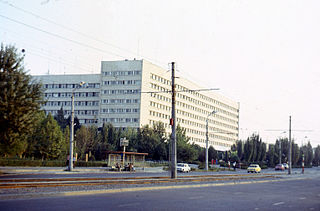
The Leningrad Military District was a military district of the Armed Forces of the Russian Federation. In 2010 it was merged with the Moscow Military District, the Northern Fleet and the Baltic Fleet to form the new Western Military District.

The Carpathian Military District was a military district of the Soviet Armed Forces during the Cold War and subsequently of the Armed Forces of Ukraine during the early Post-Soviet period.

The Turkestan Military District was a military district of both the Imperial Russian Army and the Soviet Armed Forces, with its headquarters at Tashkent. The District was first created during the 1874 Russian military reform when by order of Minister Dmitry Milyutin the territory of Russia was divided into fourteen military districts. Its first commander was Konstantin Petrovich von Kaufman, who was also Governor-General of Russian Turkestan at the time.
The 78th Rifle Division was an infantry division of the Red Army, formed in 1932, in Novosibirsk, in the Siberian Military District. After being used to provide cadres for new divisions, in September 1939 the division was reformed for the second time. In 1940 the division was transferred to Khabarovsk in the Far Eastern Front.
The 36th Army was a military formation of the Red Army and the Soviet Ground Forces, formed twice.
The Volga Military District (PriVO) was a military district of the Soviet Union and the Russian Federation that existed from 1918 to 1989 and 1992 to 2001.
The 23rd Guards Motor Rifle Division of the Soviet Union's Red Army was a Motor Rifle Division active during the Cold War. After 1991-92, the Division's remnants were eventually incorporated into the new Army of Azerbaijan.

The 19th Guards Mechanized Brigade is a formation of the Armed Forces of Belarus based in Zaslonovo (ru:Заслоново), a few kilometers east of Lepiel. The 19th Guards Brigade traces its history back to the 1942 formation of the 2nd Guards Mechanized Corps of the Soviet Army during World War II. Subsequent designations during the Cold War included 2nd Guards Mechanized Division and 19th Guards Tank Division. Following the Cold War, the 19th Guards Tank Division was relocated to Belarus and became part of their armed forces in 1992. Thereafter, the unit was reduced to a personnel and equipment cadre unit and titled the 19th Guards Base for Storage of Weapons and Equipment before being upgraded to a mechanized brigade in 2008.

The 8th Tank Army was one of ten Soviet tank armies. It was formed from the 52nd Army after the end of World War II. It was stationed around the city of Zhytomyr, in the western Ukrainian SSR, part of the Carpathian Military District. During the Cold War, the army was involved in the crushing of the Hungarian Revolution of 1956, Operation Whirlwind, and the crushing of the Prague Spring, Operation Danube. After the Dissolution of the Soviet Union, 8th Tank Army became the Ukrainian 8th Army Corps.
The 13th Guards Army Corps was a corps of the Soviet Ground Forces, formed from the previous 13th Guards Rifle Corps which saw service during the Second World War.
The 91st Motor Rifle Division was a division of the Soviet Army, formed twice. The division was first formed from a rifle division in 1957 and disbanded two years later. The division was reformed in 1970 without inheriting the lineage of the first formation, and was stationed in Mongolia between 1979 and 1987. After being pulled back to the Soviet Union it was downsized into a territorial training center, which later became a storage base.
The 199th Motor Rifle Division was a motorized infantry division of the Soviet Army from 1970 to 1989. The division was based in Krasny Kut, Primorsky Krai and became a storage base in 1989.
The 62nd Motor Rifle Division was a motorized infantry division of the Soviet Army. It was originally formed as a mobilization division in 1972 but became a regular division months later. It became a storage base in 1989 and was disbanded in 1994.
The 89th Motor Rifle Division was a motor rifle division of the Soviet Army, formed twice. The division was first formed in 1957 from the 14th Mechanized Division, which was the former 284th Rifle Division. In 1966, it was reformed as a mobilization division. In 1987, it became a territorial training center and a storage base soon after. It was disbanded in 1996. The unit was based at Tambov.
The 12th Motor Rifle Division was a motorized infantry division of the Soviet Army, formed twice. It was formed in 1957 from the 12th Rifle Division and disbanded in 1958. The division was reformed in 1960 and moved to Baganuur in Mongolia in 1979. It pulled out of Mongolia in 1990 and became a storage base in 1992. The storage base was disbanded in 1993.
The 76th Tank Division was a mobilization tank division of the Soviet Army. It was based in Brest and became a territorial training center in 1987. The training center became a storage base in 1989.
The 265th Motor Rifle Division was a motorized infantry division of the Soviet Army during the Cold War.
The 80th Guards Training Motor Rifle Division was a training unit of the Soviet Army during the Cold War.
The 4th Guards Motor Rifle Division was a motorized infantry division of the Soviet Army during the Cold War.








